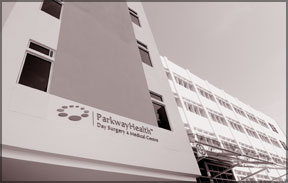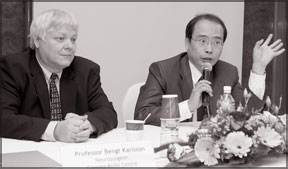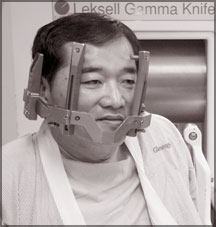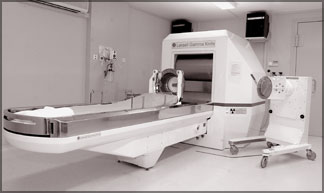Making a difference through excellent patient care
Official opening of the Parkway Gamma Knife Centre,
Singapore:
By Samangie WETTIMUNY
[email protected]
He who has health, has hope, And he who has hope has everything. An
ancient proverb which I have often heard as a child comes to my mind
incessantly. Anyway one need not necessarily know any proverb to feel
the devastating emotional blow a family undergoes when a critical
illness strikes a family member all of a sudden.
Should a person lose all hopes and becomes nobody just because his
doctor diagnoses that he has a brain disorder- either a brain tumour or
vascular malformation- or simply any other serious illness? Certainly
No. Miracles of modern technology supported by sincere expression of
caring and sharing can help him and his family turn the grief of
futility and despair into grief of hope and release! I came face to face
with yet another valiant fighter who did not lose his smile and his good
spirits as a result of his illness, away in Singapore, at the Parkway
Health Day Surgery and Medical Centre of Parkway Group Health care
-Singapore’s first private health care provider to earn the prestigious
Joint Commission International (JCI) accreditation for all its three
hospitals-East Shore, Gleneagles and Mount Elizabeth.
|

The exterior of ParkwayHealth Day Surgery and Medical
Centre, where Gamma Knife Centre is located. |
Soon after undergoing Gamma Knife surgery, Chan Wahnam(56), was ready
to speak to all of us, journalists from all around the globe who had
gathered at Parkway Health Day Surgery and Medical Centre in Singapore
to participate at the official opening of the Gamma Knife Centre of
Parkway Health. Though the official opening ceremony was on October 9,
2008, the centre was in operation since June and more than 51 patients
have been treated up to now, and at present Parkway Health’s Gamma Knife
centre is the only provider of Gamma Knife surgery in Singapore.
Conventionally, brain tumours and other disorders have been extremely
difficult to treat, often requiring delicate and invasive neurosurgery.
However with the introduction of Gamma Knife radiosurgery, treating a
brain tumour is no longer an arduous and time-consuming procedure,
medical experts say.
Of course now I have evidence right in front of me. “I don’t feel any
discomfort at all.” Mr. Wahnam tells us with a smile after taking the
treatment in the Gamma Knife Suite for more than an hour. I could see
“hope” in his eyes. “If you have hope, you have everything.”
“He can return home today or tomorrow morning.” says Dr. Yeo Tseng
Tsai, Medical Director of the Gamma Knife Centre patting affectionately
Wahnam’s shoulder as he leaves the room, of course well supported by the
caring hands of the Parkway Health assistants.
No wonder why the Gamma Knife treatment was continuously referred to
as the “gold” standard for radiosurgery by all the panellists who
attended the press conference which was held to mark the official
opening of the centre. Addressing the journalists a smiling Prof. Bengt
Karlsson, the internationally renowned Swedish expert in Gamma Knife
radio surgery who has been actively involved in setting up of the centre
said that Gamma Knife is an excellent treatment for suitable patients.
In fact Parkway Health’s Gamma knife Centre is a collaboration between
Prof. Karlsson and the Parkway Health. He recalled how the Gamma Knife
was introduced by Swedish neurosurgeon, Lars Leksell in 1967 and
explained the evolution of Lexell Gamma Knife through out the centuries.
As the Vice President of Elekta, the world leader in image guided and
stereotactic clinical solutions for radiosurgery and radiation therapy,
Rolf Kjellstrom talked in great detail of the clinical challenges Elekta
has to cope with, when providing clinically effective, cost efficient
and safe treatment with minimal risk for complications while preserving
quality of life. As the only company that could supply the whole range
of necessary solutions, Elekta gives radiation oncologists and
neurosurgeons an unmatched capability to aggressively treat tumours and
functional targets with ultra-high precision while sparing health
tissue. Elekta has introduced a complete product range of Lexell Gamma
Knife Perfexion, Leksell Gamma Knife 4C and Lexsell Gamma Knife 4.
Out of his years of experience in the medical field,Medical Director
of the Cancer Centre, Dr.Yeo Tseng Tsai said that most of the patients
who have brain disorders (or any) prefer not to have their heads cut
open. He further explained as to how radiosurgery is minimally invasive,
patient friendly and can be broadly applied. The risk is low.
“Technologies do matter. Technologies can be refined.” But he cautioned
that there can be high risk if done inappropriately or incorrectly.
Talking of indications for radiosurgery he dealt with two issues- type
of lesion and size/volume of lesion. There are three categories of
lesions:
|

Dr Yeo Tseng Tsai , Medical Director of ParkwayHealth's
Gamma Knife Centre, speaks at the press briefing to mark the
official opening of the Centre, Professor Bengt Karlsson,
neurosurgeon and visiting consultant, looks on. |
Category A: is very strong evidence based, well accepted and
non-controversial. Vestibular schwannoma/Acoustic neuroma, AVM, cerebral
Metastasis or metastases and meningioma fall into this category.
Category B: Strong evidence based-gaining widespread acceptance.
Pituitary tumours, Trigeminal Neuralgia can be given as examples.
Category C: Some evidence present although mostly anecdotal still.
Glioma, Craniopharyngioma, pineal tumours, central Neurocytoma,
Ependymoma, Medulloblastoma, cavernoma, thalamotomy, pallidotomy,
epilepsy surgery-hippocampectomy and Epilepsy surgery-hypothalamic
hamartoma are identified as lesions of this category.
Explaining the volume of lesion Dr. Yeo said that in general 20cc is
the stated official cut-off. “But in reality it depends on the doses
prescribed and the location of the lesion.” Speaking at the opening
ceremony held in the evening of October 9, at the Gamma Knife Centre,
Richard Seow, Chairman of Parkway Holdings Ltd once again emphasized the
importance of Gamma Knife surgery in treating brain disorders.” It has
been proven to be an effective and reliable surgical treatment for brain
tumours; and with the talents leading our Gamma Knife Centre, patients
will benefit from this gold standard treatment method.” As he emphasized
the adoption of this proven technology complements the range of advanced
neurological care at ParkwayHealth, enabling them to provide a
comprehensive service for their patients.
Occupying 2,224 square metres area on the ground floor of the PDSMC,
now the Parkway Health makes use of the latest technologies, such as
Gamma Plan 8.2, the most up-to-date dose planning software available for
the Gamma Knife machine. When it comes to dealing with the intricate
nervous system, every second counts. In fact neuroscience is just one
out of Parkway Health’s eight clinical programmes. The others are heart
and vascular, musculoskeletal,oncology, primary care and chronic disease
management, surgery, transplant and cellular therapy and women and
children.
Parkway Cancer Centre which is attached to the Gleneagles hospital
has a panel of efficient doctors to treat its patients with dignity and
respect.
Not only Singaporeans are benefited by the latest health facilities.
Parkway health operates more than 43 International Patient Assistance
Centres (IPAC) located around the world.
|

Chan Wahnam(56) gets up after undergoing Gamma Knife surgery
at the Parkway Health Gamma Knife Centre . |
We all know that Singapore is Asia’s leading medical hub. It has gone
on record thar every year around 400,000 overseas patients visit
Singapore for advanced medical treatment.
In 2000, the World Health Organization ranked Singapore’s health care
system as the sixth best in the world and the best in Asia.
Anyway there is also a cross section of people who are sceptical of
the private health care sectors as they view it solely as yet another
lucrative money -making venture. “There are some who say that we build
new hospitals to attract more patients. More patients mean making more
money, and that is how they see it.” Shuvo Hridayesh, Parkway Health
country Manager, International Patient Assistance Center, Sri Lanka
tells me., explaining that it is very wrong to think in those lines.
We do not want people to fall sick. But certainly they need
assistance when they fall sick.” Parkway Health’s mission is to make a
difference in people’s lives through excellent patient care.” So is his
wish.
Maladies will never give advance notices.
The stark truth is if you are a living being you fall ill and
specially when a fatal illness hits you like a bolt from the blue you
need a ‘trustworthy’ and a caring person to fall back on. Happiness is
always relative and it depends on how you define it. But I am sure that
you all would agree with me if I say happiness is nothing more than good
health!
***********************
Gamma Knife - Gold standard for radiosurgery
The Gamma Knife is recognised internationally as the most advanced
radiosurgical treatment modality for deep-seated brain tumours and other
lesions that cannot be removed safely using conventional brain surgery.
What is Gamma Knife?
|

Gamma Knife Unit at Gamma Knife Centre |
Gamma Knife was invented by Swedish neurosurgeon Lars Leksell in
1967. It is a form of stereotactic radiosurgery used to treat some brain
disorders( such as brain tumours and vascular malformations), without
the need for open surgery. Although it was named Gamma Knife, it uses
gamma rays instead of a surgical knife. Computer-planned finely
collimated gamma -rays are precisely focused at the target in the brain
without affecting the surrounding healthy tissues. It is performed as an
outpatient surgery procedure and the patient can return home the same
day or the next morning, depending on the advice of the neurosurgeon.
What can be treated by Gamma Knife?
1. Brain tumours
Both benign and malignant brain tumours, especially tumours
originating elsewhere in the body that have metastasised to the brain.
 2. Arteriovenous Malformations (AVMs) 2. Arteriovenous Malformations (AVMs)
AVMs are an abnormal collection of blood vessels. When located in the
brain, these abnormalities can cause bleeding, headaches or seizures.
3. Acoustic Neuromas/Vestibular Schwannomas
These non-cancerous tumours develop on the nerve that affects balance
and hearing, often causing gradual hearing loss, tinnitus and dizziness.
4. Trigeminal Neuralgia
This nerve disorder affects the trigeminial nerve, one of the largest
nerves in the head that causes sudden disabling facial pain that feels
like an electric shock-like or stabbing pain.
5. Pituitary Tumours
Pituitary tumours are abnormal growths that develop in the pituitary
gland, a small organ about the size of a pea, located in the centre of
the brain. These tumours can cause a variety of problems because the
pituitary controls the thyroid, adrenal and reproductive glands.
Benefits of Gamma Knife Treatment
1. It is a non-invasive surgery. The gamma-rays are focused at the
abnormal lesion without affecting the normal adjacent tissues.
2. The treatment gives very good results comparable or superior to
conventional open-surgery with no risk of bleeding or infection. It also
has a much lower risk of morbidity and morality compared to open
surgery.
3.Treatment is usually done as a day surgery procedure. Hospital
stay, if any, would be overnight at the most. By comparison conventional
surgery would require 1-2 days of intensive care stay, with 7-14 days of
hospitalisation (depending on the case.)
4.Patients undergoing Gamma Knife treatment can return to their
pre-operative lifestyle almost immediately, compared to 4-6 weeks of
convalescence required for those who undergo conventional surgery.
******************
Treatment procedure
Frame fixation
Before a Gamma Knife radiosurgery procedure is done, a light weight
metal head frame (a stereotactic frame) which ensures that the radiation
beams are exactly targeted, is attached to the patient’s head in the
preparatory room.
Localising the target tissue
Magnetic Resonance Imaging (MRI), Computed Tomography (CT) or
Cerebral Angiography is then carried out to determine the exact size,
shape and position of the treatment area in the patient’s brain.
Computerised Treatment Planning
After the scan, patient will take a rest at the recovery area. From
the MRI images, the neurosurgeon uses computerised treatment planning to
decide on the dose and positioning of the rays. The treatment planning
ensures that the dose delivered is accurate and just sufficient to
neutralise the tumour target.
Gamma Knife treatment
As the treatment planning is completed, the patient undergoes the
treatment in the Gamma Knife suite. The whole process takes about 1-3
hours(depending on the size and configuration of the lesion) and does
not involve any surgical incision.
After the treatment procedure is completed, the frame will be
removed. Patient will then have a few minutes of rest in the recovery
area. Patient can return home the same day or the next morning.. |

